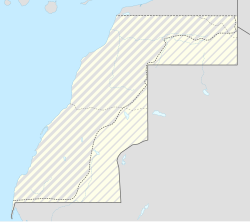Cape Bojador
|
Cape Bojador بوجدور Cabo Bojador |
|
|---|---|
| Location in Western Sahara | |
| Coordinates: 26°08′N 14°30′W / 26.133°N 14.500°W | |
| Territory | Western Sahara |
| Controlled by | Kingdom of Morocco |
| Claimed by |
|
| Population (2006) | |
| • Total | 41,178 |
Cape Bojador (Arabic: رأس بوجادور, trans. Rā's Būjādūr; Berber: ⴱⵓⵊⴷⵓⵔ, Bujdur; Spanish and Portuguese: Cabo Bojador; French: Cap Boujdour) is a headland on the northern coast of Western Sahara, at 26° 07' 37"N, 14° 29' 57"W. (Various sources give various locations: this is from the Sailing Directions for the region.), as well as the name of the large nearby town with a population of 41,178. The name of the surrounding province also derives its name from the cape (Bojador Province).
It is shown on nautical charts with the original Portuguese name "Cabo Bojador", but is sometimes spelled "Cape Boujdour" in some media and academic research. It is said that it is also known as the "Bulging Cape", although no references to this usage are to be found in standard geographical references. The Cape's name in Arabic is "Abu Khatar", meaning "the father of danger".
The cape is not prominent on maps but may be located by looking 220 km (120 nautical miles) due south of the south-western point of the hook of Fuerteventura, Canary Islands.
The discovery of a passable route around Cape Bojador, in 1434, by the Portuguese mariner Gil Eanes was considered a major breakthrough for European explorers and traders en route to Africa and later to India. Eanes had made a previous attempt in 1433 which resulted in failure, but tried again under orders of Prince Henry the Navigator, who first sent him in 1424. He was successful after the second expedition. The disappearance of numerous European vessels that had made prior attempts to round the Cape despite its violent seas, led some to suggest the presence of sea monsters. The region's coastal areas quickly became a very important area for Portuguese traders, whose first delivery of African slaves to Lisbon occurred in 1434. The mythic importance of the cape for Portugal was captured in Fernando Pessoa's early 20th century work "Mensagem." In famous stanzas from this longer poem Pessoa wrote of the enormous costs of the Portuguese explorations to the nation. Capturing the symbolic importance to the nation of rounding Cape Bojador, Pessoa wrote: "Who wants to pass beyond Bojador, Must also pass beyond pain." (Quem quer passar além do Bojador, Tem que passar além da dor.) They thought the ocean was burning past cape Bojador but Henry's men went past Bojador.
...
Wikipedia

